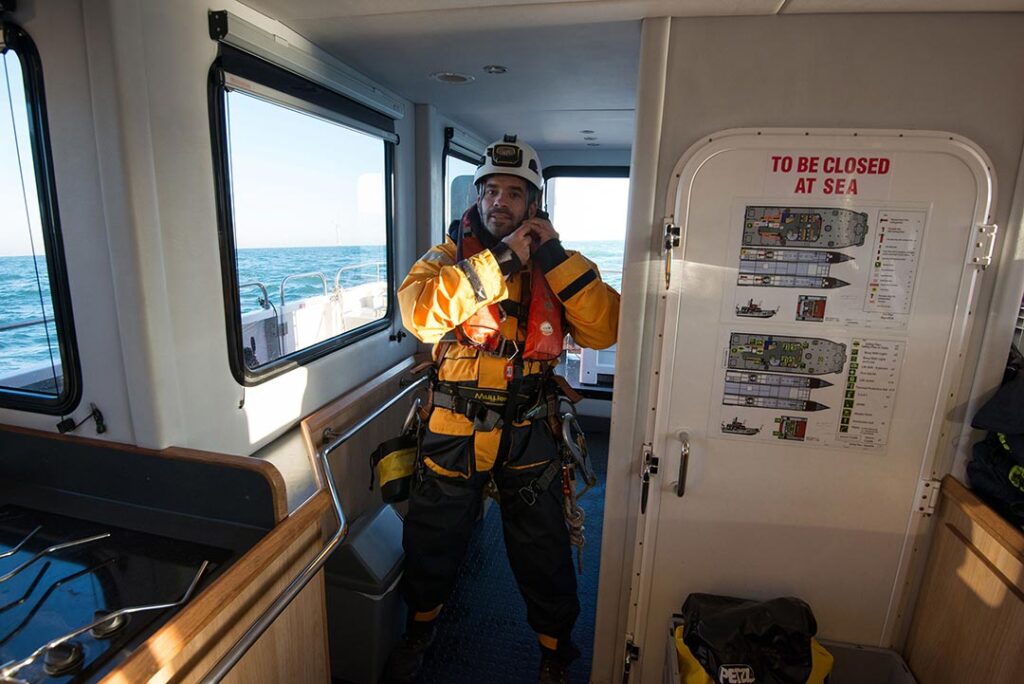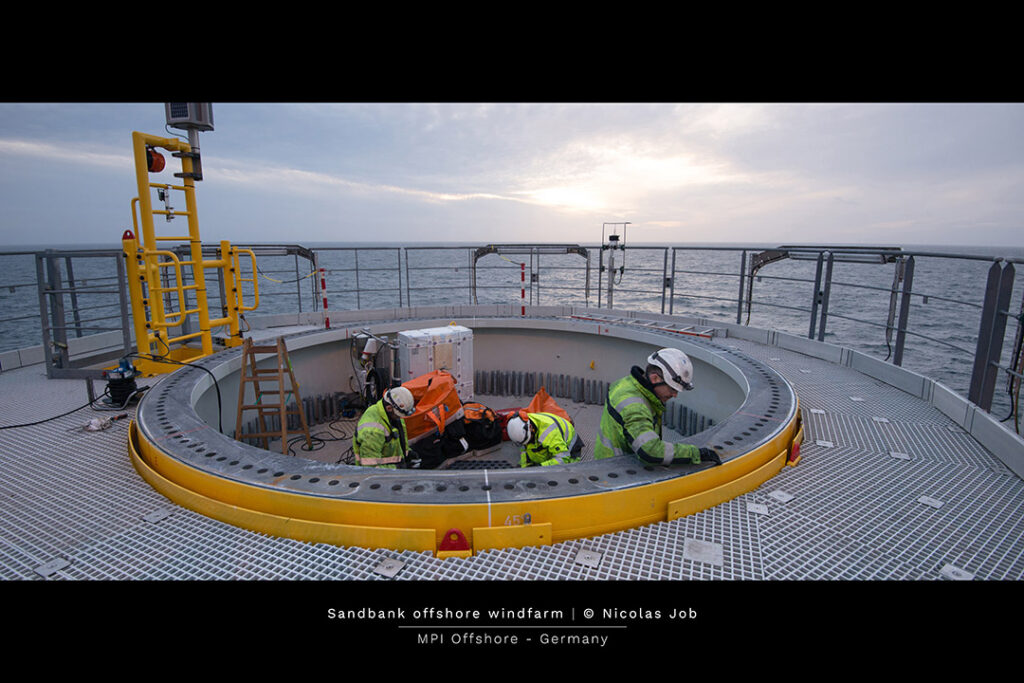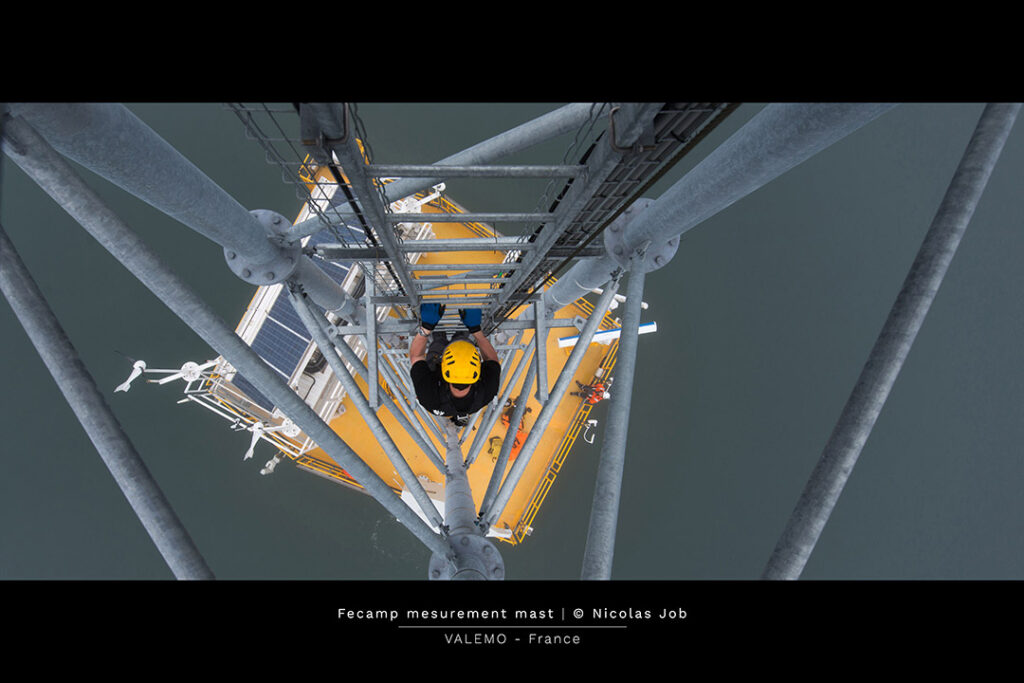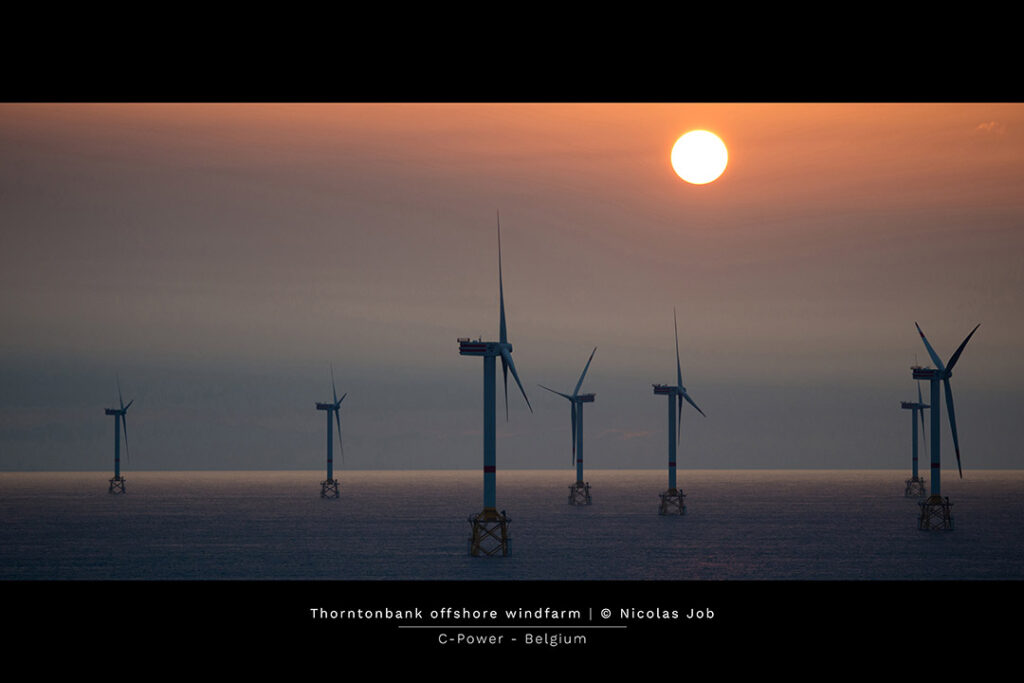Maintenance of offshore wind turbines in pictures and films
“My job is to highlight the work of people we do not often see” – Nicolas Job, photographer and filmmaker
Nicolas Job is a photographer and filmmaker from New Caledonia who for several years now has been specialising in taking pictures of offshore wind farms . In this position, he is ideally placed to survey the maintenance of those huge wind turbines and the work of the maintenance engineers and technicians.

The engineers and technicians of offshore wind turbines live on a boat for days. Nicolas Job regularly travels to various wind farms around the world to follow in the footsteps of the maintenance technicians. Here, he describes in detail life aboard a boat for maintenance technicians at sea and explains how work is carried out, high up in the wind turbines.
Nicolas, how did you get into this job?
Nicolas Job: From 2013, I expanded my business in audiovisual services to everything related to offshore wind energy. At the time, I met the communications director of the company Vattenfall in Esbjerg, Denmark. This company managed the largest offshore wind farm at the time, Horns Rev I. We talked about this together and he motivated me to film these technicians more closely, to show what their work really was.
Can you describe what your work consists of exactly?
Nicolas Job: My job is to make photo reports and films on the work of maintenance teams, particularly in the offshore wind industry. I worked in IT for about ten years as an employee. After that I started doing underwater photography. In fact, when I did underwater photos, I said to myself: I need to have a second activity because underwater photos are very expensive. The equipment is very expensive and it’s complicated to install. So I said to myself: offshore wind turbines are starting to develop in Europe, especially in the North Sea. And then in France, there were projects by the builders of offshore wind farms. So I decided to specialise in this area with accreditations so that I could follow the technicians closely, take photos of them, show what their work is really like.
For a long time, when the communication departments of these companies that were building farms needed to bring in photographers or cameramen, they put them in helicopters and went around the farms by helicopter. So it was fairly easy for the managers of the farms, but in return, it was always the same photos that we saw, never photos where we were inside the construction sites or with the maintenance teams. So I specialised in this area and for about ten years I had the opportunity to travel to the North Sea either to follow the construction of these wind farms or to follow the work of the maintenance teams.

12-hour shifts
My job is really to highlight the work of people we do not often see. Because we never talk about maintenance. We often talk about construction, projects, and so on. We talk about the engineers who are on the projects, but we never talk about the maintenance that is behind these projects. I am highlighting the maintenance teams, what they do on site.
I also filmed a boat, the Wind of Change. It is a boat belonging to a French shipowner. He called me two years ago, because they needed someone to make a film of the boat. I spent 19 days on this boat to make the film. It was in Germany, in the Borkum-Riffgrund farm, which has 78 wind turbines. Such a boat is perfectly equipped to drop the technicians and their equipment off at the wind turbines in the best possible conditions, even in rough seas.
In the film we follow the technicians. What does a 24-hour day look like for a technician?
Nicolas Job: There are 12-hour shifts. Often, during the day, the technicians will get up at about 4 or 5 o’clock and go to the canteen to have breakfast. The canteen is open 24 hours a day: there is breakfast, but also meals with meat, fish, chips, … you can eat whatever you want. There are also teams who finish their 12 hours and have a big meal before going to bed. Vessels like the Wind of Change are truly floating hotels.
In any case, at six in the morning there is a so-called toolbox meeting. Here, the interventions of the day are prepared. During the meeting, the engineers explain the work to be done during the day, but also the problems they encountered the day before and how they found solutions to them. This meeting is organised by the project manager or the team leader. All the technicians are present. Depending on the project, the meetings can be bigger or smaller. During the meeting, the project manager lists all the turbines to be covered that day. Everyone listens, takes notes and signs to say they heard the instructions . Afterwards, the technicians get ready and go to the warehouse to get the materials they need for the day’s maintenance. Then they are ready to set off to the turbines.

Rough sea
When the technicians leave for the turbines, a large cube-like bag weighing 500 kg is sent with them. Those big bags can often contain a small power generator or a compressor to be able to use compression tools. It may be a small thermal compressor that is useful for smoothing bolts very well. Large quantities of oil are also carried, as much of the maintenance in wind turbines involves re-lubricating the parts that turn, such as the blades. Electronic parts may also be included. In a wind turbine, for instance, a motherboard has to be replaced regularly. And huge amounts of water. In the wind turbine workspace, it can get quite hot at times, so it is important that technicians have water to hydrate themselves.
The technicians carry their own equipment in small backpacks. Once all the safety measures have been taken, they take the lift to go to the bridge by which they connect to the wind turbine. The huge bag is transported by a special crane, which takes into account the movements of the swell: the crane follows the movements of the waves, which allows the package to be placed on the wind turbines even when there are a lot of waves and the sea is very rough. So, due to this special compensation technique, the bag can be precisely set down on what is called the TP (i.e. the ‘transition piece’), often a section of the wind turbine marked in yellow where the technicians can step onto the bridge. They go up and they are put there for the day. In the evening they are collected. And when they’re picked up, another team takes over. The technicians of the next team can again proceed in the same way, with the gangway and the crane, or they can also be transported by another boat, a crane boat, attached to the mother ship. They can enter the crane boat directly from the mother ship, which sets them down directly on the turbines.

The technicians also work at night: there are two 12-hour shifts, you said. So maintenance on offshore wind turbines runs 24 hours a day?
Nicolas Job: They try to have 24 hours, but often it’s not possible because there are constraints. Often, the second shift works until 10 or 11 o’clock in the evening and then they get everyone back. Ultimately, they want to spend as little time as possible near the wind turbines at night. This limits the risks.
How long does a boat like this stay in a wind farm for the maintenance of the wind turbines?
Nicolas Job: When the technicians come on board, they usually stay for 15 days. That means: they spend 15 days at sea and then 15 days on land and then it starts again for 15 days at sea. I stayed for 19 days, because 15 days at sea may well be longer if the work requires it. That happens, for example, when they realise they have to do operations that will take a bit longer to finish. If they then have to drop people in port and come back, they lose too much time, so they prefer to finish everything. That’s why I stayed for four days longer than originally planned.
Helicopters
In the film, we see that the technicians are also picked up by another boat. What is the reason for this?
Nicolas Job: The maintenance boat has about 100 people on board for these 15 days: 20 crew members and 80 people working on the wind turbines, and of those 80, about 20 people oversee the whole operation and advise the technicians. In a wind farm, there are always some wind turbines that require maintenance. Sometimes maintenance may need to be carried out on other, nieghbouring farms . But those farms are also very far from the coast. Therefore, full use is made of a nearby boat. Specifically, crane boats are used: these are boats that come in front of the big boat and pick up technicians to take them to other parks that are very far away. So there is a fixed base of operations, which involves the main boat being in the central zone full time and these small boats going from one place to another to take people to other zones for maintenance work .
Are helicopters also used for maintenance?
Nicolas Job: There are also helicopters for the wind farms located about 10 kilometres from the coast, where weather conditions are sometimes too complicated to intervene. There are helicopter companies that provide helicopters to bring technicians and equipment on board of the wind turbines.
And you are in a helicopter to do your work as a photographer?
Nicolas Job: When we took the pictures of the helicopter involved in the maintenance, I was in another helicopter. In fact, there were two helicopters at the wind farm. One that dropped off and picked up the technicians and another one that was there especially for us to take the photos and videos.
Do you also use drones?
Nicolas Job: I have also made films with drones, but it is very complicated in wind farms, because there are a lot of helicopters hanging around and flying around all the time. And for example, in the North Sea, there is only one centre that oversees the whole area, and that is in England. First we have to fill out a lot of documents to get some kind of accreditation from the farm managers, and once we have it, every time we let the drone take off , we have to call the centre in England that oversees all helicopter traffic in the farms. They are the only ones that can give permission to fly the drone or not.
Lego box
Do you take pictures of all the farms? Don’t all the farms look the same then?
Nicolas Job: It is certainly true that they are all somewhat similar. But often it is the clients who ask for the photos and they want their own farms. I was in China once to take pictures of offshore wind farms. And there, the water is brown. So you cannot say you will use the photos you took in the North Sea and make them pass for a Chinese wind farm. Because there the water has a totally different colour. So there are differences after all.

And you were also up there in a wind turbine?
Nicolas Job: Yes, I went to the top of the wind turbines about 10 times to follow the engineers who were building the turbines. Generally, wind farm maintenance engineers work at a height of 100 metres. I was there to follow the blades being fixed and the final stages of the construction of the wind turbine. I even have one of my pictures on a Lego box, of which the theme is the construction of wind turbines at sea. When I worked on the construction of the Borkum-Riffgrund wind farm and Lego bought part of this wind farm for the electricity used at its plant, they made a small Lego box of the construction of these wind turbines and they needed some photos to illustrate it. So, they put one of my photos on the box.
The wind turbines stop working as soon as a maintenance crew is deployed?
Nicolas Job: When maintenance is carried out the wind turbine is in any case stopped . And these wind turbines are controlled remotely. Everywhere where there are wind farms, in Germany, Belgium, England, etc., there are central control units. From there it is decided that intervention is needed in a specific wind turbine, e.g. the F25 of that particular wind farm. Then in that control unit, the decision is made to switch off the power and once that is done, the maintenance crew can intervene.
What do you think are the main challenges in offshore wind turbine maintenance?
Nicolas Job: Maintenance in offshore wind is very expensive. It is assumed that during the 20 years an offshore wind farm is in operation, maintenance costs are about double the construction costs. The weather conditions must be ideal in order to place technicians on the wind turbines, with a maximum swell of 1.5 metres. This means that maintenance companies often have to use helicopters, increasing maintenance costs.

